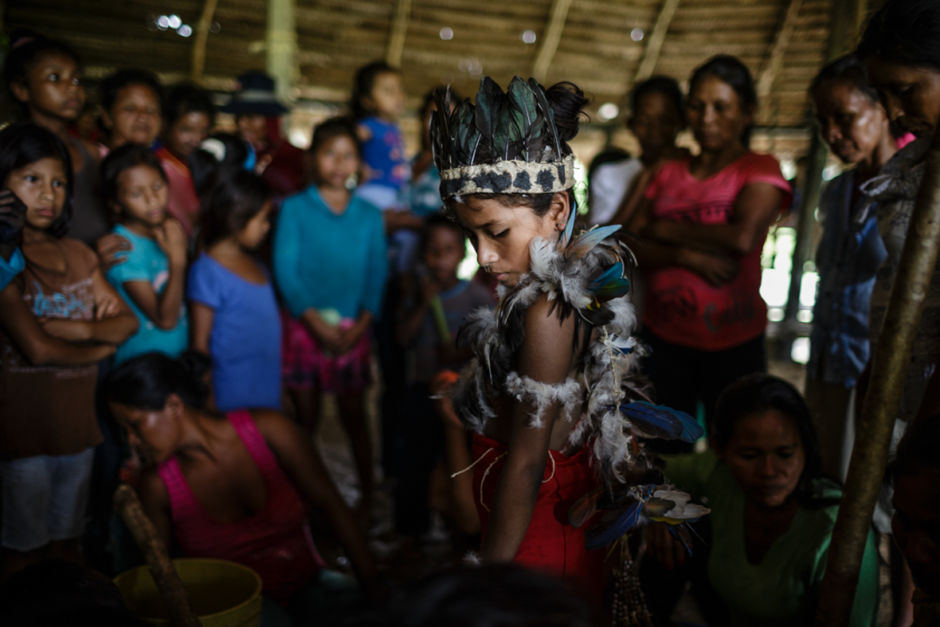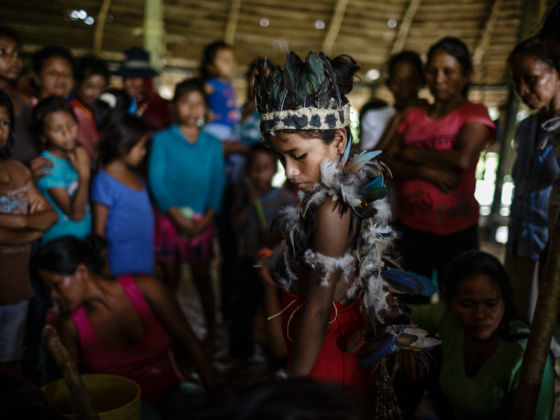
Coming of age in
the Amazon jungle
into womanhood after a year-long isolation.
In a small settlement, deep in the Amazon rainforest, colourful preparations are underway for a very important occasion.
The village of Puerto Esperanza, directly translated as “Port Hope,” is located in the Amazonas department of Colombia — three hours travel by boat from Leticia, the main port in the Colombian Amazon. Here you will find many members of the Tikuna tribe. One of the most numerous tribes in the rainforest, the Tikuna are an extraordinarily artistic people, known for their rich culture and age-old traditions.
One of the most prominent cultural traditions celebrated and upheld by the Tikuna is that of the Pelazón ceremony, a coming of age ritual for young girls, marking the time they enter womanhood. After a whole year of isolation, the girls will be welcomed back into the tribe as women.
At the center of the settlement, in the maloka, or gathering house, people begin the preparations for the rituals that will take place during the Pelazón ceremony. They bring together wine and food that have been collected from the community and spend hours crafting elaborate feathered drums that will be used during the festival.
One young man plays a whistle to mimic the jungle sounds and imitate the demons who are lingering near the maloka, while another heats a fish-skin drum to hone its sound in preparation for the festivities.
Meanwhile, other community members are making uito, a natural pigment that will be used to cover the girls’ bodies during the ceremony.
A year in isolation
Following her first menstruation, each young Tikuna girl who has chosen to take part in the ritual and Pelazón ceremony will isolate herself in a small house made of palm leaves. For an entire year, the only person whom she will be allowed to see is her grandmother. Part of a deep cross-generational relationship, the elders teach the young girls many skills from weaving, cultivating crops, and the uses for plants, to taking care of babies, and every other aspect of being a Tikuna woman.
Below you see a grandmother brushing her granddaughter’s hair. This girl is only seven but has already decided that when the time comes she wants to take part in the Pelazón ritual and ceremony.
The reunion
After the long year of isolation, the girls’ families work together to prepare a big celebration, inviting the whole tribe to welcome their daughter as a young woman, and back into community life. The celebrations last for three days with drinking, eating and dancing, but first, everyone gathers in a procession around the village, gathering all of the young girls, in order to take them to the maloka.
Members of the tribe bring animals they have hunted as offerings to the girls’ families. This young man is holding a Terecaya in his hands, a species of amazonian turtle. The shell is decorated with feathers and hung in the maloka as a symbol of wisdom in the Tikuna culture.
As night falls, the procession continues to make its way around the village, one by one collecting each of the young girls.
Below is the moment one of the girls comes out of isolation. She will be completely covered until she is ‘revealed’ during the main ceremony.
The ceremony
At the heart of the Pelazón celebrations, is the big communal feast held in the maloka. The families offer a typical payabarú drink to their guests, people dance to traditional songs, and, in the midst of this feast, the girls come out dressed in feathers and painted with uito pigment.
The girls are unveiled for the first time in their elaborate feather headbands. Below one of the newly welcomed young women dances as part of the ceremony, while the other women look on.
During another important part of the ceremony, members of the tribe dress as demons and dance around the girls, enacting temptations that the girls are strong enough to face, now they are women. They wear masks, shake instruments, and carry carved wooden penises to symbolise the seduction that the young women may encounter in life.
After the ceremony each girl is said to be ready to embark on her adult life. The long time away with her grandmother as her teacher and the climactic return have prepared her for all aspects of her future, from work, to marriage, to pregnancy, and having a family of her own.
It was a privilege to spend time with the community and families of Puerto Esperanza and to observe the Tikuna’s remarkable Pelazón ceremony. I want to give special thanks to Edgar, Otoniel, Obsimar, Vicente, and all the other tribe members who allowed me to participate and photograph this very special and private ritual.
Explore more of my work at federicorios.net
This article originally appeared on Maptia and is republished here with permission.
